Making his feature directorial debut with SURVIVING CONFESSION is MATTHEW TIBBENHAM. A veteran director of numerous shorts, not to mention garnering experience with the camera working on films like “Deliver Us From Evil” and Scott Derrickson’s “Sinister”, Matthew knows his way around and through a story and how to visually bring that to life.

Not knowing what to expect on screening SURVIVING CONFESSION, it was more than pleasantly surprising to find it filled with sharply written and acted humor that is laugh-out-loud funny from start to finish, but with some truly sobering and thoughtful moments of reflection. Written by Nathan Shane Miller and starring Clayton Nemrow as “Father Morris” and Jessica Lynn Parsons as non-parishioner but confessional crashing “Amber”, the film is essentially a two-hander that, in addition to the performances and chemistry between Nemrow and Parsons, benefits by the talents of cinematographer Mark Farney who keeps the visuals interesting while steeping them in metaphor as a layer of storytelling. So solidly constructed is the dialogue that Tibbenham could easily translate this into a stage play.
Set in the confines of a parish confessional, SURVIVING CONFESSION focuses on the stories of Amber and Father Nemrow with added wit and situational comedy courtesy of “drop-in” confessing congregants played by, among others, Jayne Marin, Kevin Ging, Sarah Schreiber, Ken Gamble, and Jerry Bornstein. Each is a stand-out thanks to their exchanges with Nemrow’s Father Morris, a man-of-the-cloth becoming more and more agitated and unsure of himself as the night goes on, all driven home thanks to the rapid-fire sarcasm fueled exchanges with Parsons’ Amber. The entire film is a delicious tete-e-tete as thed disgruntled and conflicted Father Morris has his world turned upside down by Amber.
Leaving no stone unturned, Tibbenham is sure-footed in his direction and in the film’s construction, capitalizing on the challenges presented by a one-set format with attention to detailed and exacting production design and set dress, not to mention Farney’s cinematography.
Speaking at length with MATTHEW TIBBENHAM, he is candid and pragmatic, the latter a good quality to have in the world of independent filmmaking. He also presents with a good sense of humor. But most striking is how very self-assured and confident he is in his decision-making and directing abilities, something that is proven with just one look at SURVIVING CONFESSION. . .
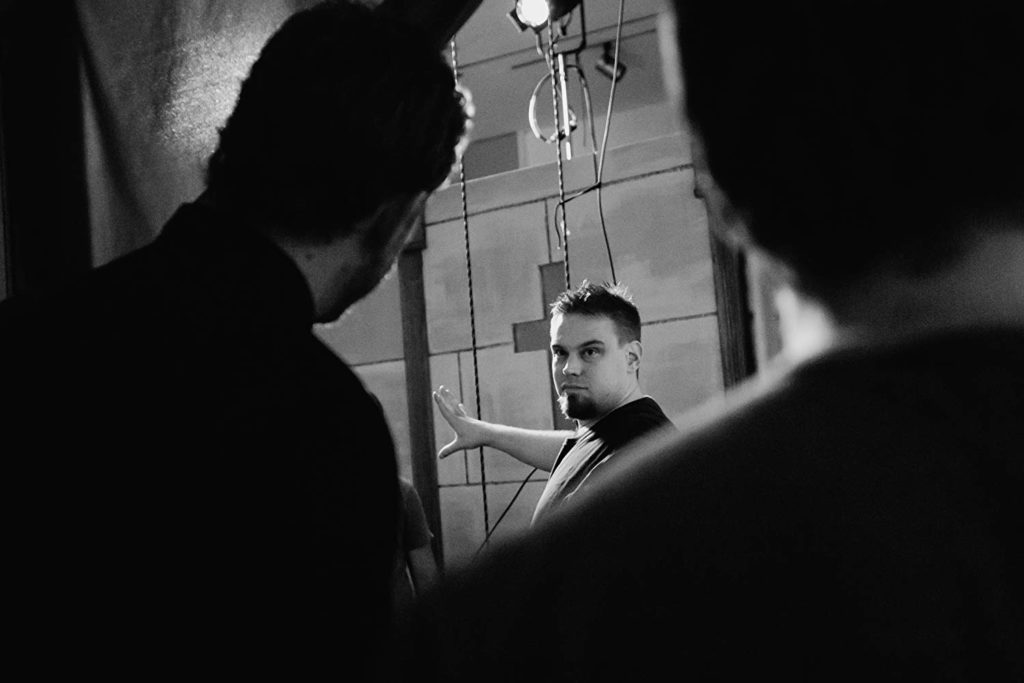
Laughing non-stop through 90% of this film, Matthew, kudos not only to your casting but to your cinematography and particularly DP Mark Farney’s lighting. But let’s start with Clayton Nemrow and his character of Father Morris. Doing exposition work for you when it comes to Father Morris is Farney’s lighting. There’s generally a shadow on one half of his face, which I find very interesting because of the whole idea of dark and light, good and evil and he’s at a crossroads emotionally as to where his future lies. But in watching Clayton, have to say that I kept thinking “Greg Kinnear, Greg Kinnear, Greg Kinnear.” He comes across as a Greg Kinnear. He should bill himself now with, “‘You’ve got a low budget film? You can’t afford Greg Kinnear? Hire me.”
That’s interesting. [laughing] We were going for, well, a Hugh Laurie vibe. But, he would love that, I think!
How did this film find its way to you? This is your first feature directorial as well, isn’t it?
Yeah. It’s been a long road, honestly. I’ve been making movies for almost a decade now; just short films, web series, TV pilots. And the long story of it is that Shane’s script… Well, he sent a script actually to my former boss, Scott Derrickson. I did “Sinister” with him, “Deliver Us From Evil”, and then he went on to do small movies like “Marvel’s Doctor Strange”.
Yeah, just little things, little things. [laughing]
Little things. It’s sad where his career’s gone, but hopefully, he’ll get back on top. [laughing] I would read all these scripts that Scott would get, because people always said, “Hey Scott, you want to make my movie? Do you want to direct this? Do you want direct this?”, and a producer friend of Scott sent Shane’s script. Shane also knew Scott because they both went to Biola University in southern California. So, he sent Scott this horror script. It was this Guillermo del Toro, World War II Japanese prisoner of war camp movie, and I loved it. I was like, “This is amazing. I want to direct this.” And Scott, at the time, he was doing other things. So I went to Scott and said, “Hey Scott, do you mind if I go to this writer, or this producer, and just say, ‘Hey, I love this movie, would you consider me to direct?'” And that’s how I met Shane. I just said, “Hey, do you have anything else? Because that script, honestly, we probably need 10 to $20 million for it.” At the time, and even now, it’s like, “Who are you? Why do you want $20 million for this script?” So, I said, “Shane, do you have anything else?” We tried to get another movie made that I thought, “Oh yeah, this is more respectable.” It was a romantic comedy and we could do it for one to 5 million. Just brilliant script. We created a sizzle reel for it. And yet again, Hollywood said, “Hey, who are you two? Like, “Why would we give you even a million?” So finally, Shane and I just got frustrated and he wrote the script and said, “What do you think of this?”. And I said, “Shane, how is every script you write brilliant? We have to make it.” So then that was the start of a long, long journey.
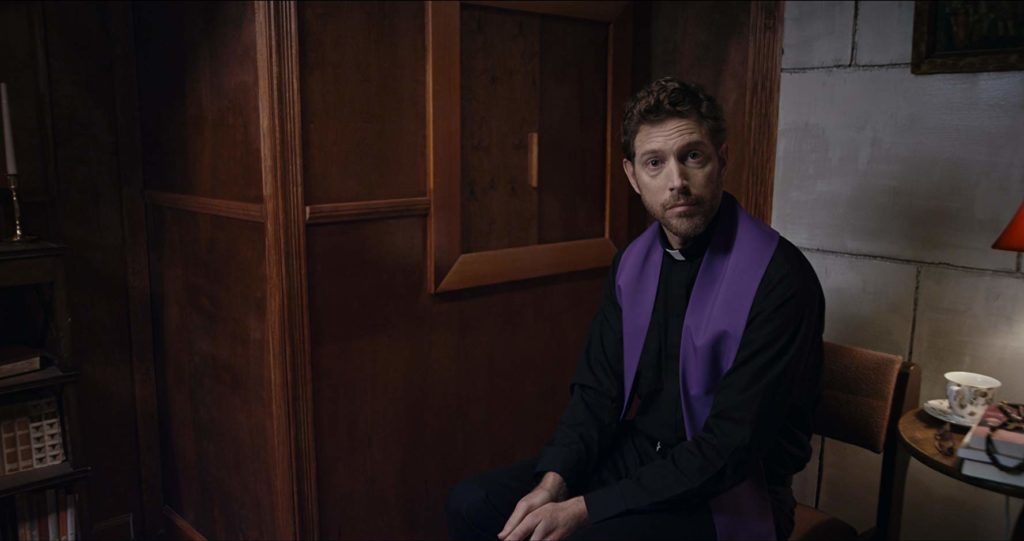
Wow! Wow! Now when you get this script and you’re looking at it, it’s like, “I want to direct this.” How was your approach with this feature? Was it different than how you approach a short? Did you immediately start thinking of casting? Or did you think of your visuals and how you were going to keep this fresh? Because everything takes place in the confessional, but for one scene. Everything is in that confessional. So, you’ve got to keep it visually interesting in addition to the excitement and the chemistry of your performances.
Very true. I think with any script I get, I ask is it something I haven’t seen before? And that’s really hard to do nowadays when they’re making hundreds and hundreds of movies a year. And is it something that emotionally impacts me, or makes me think in a way I really hadn’t thought before? With Shane’s script SURVIVING CONFESSION, even though it was sent in one location, I just couldn’t stop turning the page. I was just like, “What’s gonna happen next?” And at first you don’t really know what’s going on in the movie. This teenage girl comes into this priest’s confession, she starts to poke fun at him and start to make him question what he’s really doing in life. But you’re still like, “Well, what’s…?” When I started reading, I just had to know what happened and I couldn’t put it down. And I think for me, for scripts, that’s one thing. And also visuals. Even though it was set in one location, I just liked the idea of what can you do in one location and that kind of challenge. And with movies like “Rope” and Hitchcock, Stuart Hazeldine’s “Exam”, I probably watched every single one location movie just to see what they did. So, I probably watched 50 plus movies. I was just thinking at first the visuals and everything wasn’t in the forefront of my mind. But I was thinking, “Who could play these characters?” And at first we wanted to have it be a more reasonable budget so that it would get some named stars in it, just because that’s so important. I think the one question everybody asked me when it was done is, “Who’s in it?” I’m like, “Some really great actors. You’ll be blown away by it.” But they’re like, “Yeah, but I’ve never seen them in anything.” And I get it from the business model because if you’re just a viewer clicking through iTunes, whatever, you’re going to go watch the movie with Greg Kinnear instead of Clayton Nemrow. So, it’s just business, but it’s sad that we do that because somebody like Clay would’ve never been in this movie if it had millions of dollars of budget. So yeah, lots of stuff brings me to the script. And the same thing happened with Shane’s horror script, it hit me emotionally. I thought, “Wow, this is nothing I’ve ever seen before.” But then at least for that one, it has these amazing visuals, but that’s why it costs 20 million to make. So, in this case it was definitely just the story and the heart of it.

Initially, here we meet Amber and I get it. The way she walks in there, just plops herself down, and just goes off, “I killed a man. Yeah, no, I really did, I did.” Amber is so convinced and you get Morris’ whole thing of, “No, you didn’t; no, you didn’t.” But then, the way she keeps hammering it, you start to wonder. And this is due to Jessica’s performance and her vocal tonal quality. You can hear this conviction in her voice. The more she goes on about, “No, I did, I did,” and she starts describing things, and you hear this conviction that either she’s convinced herself, she’s a master liar and she’s convinced herself of this, or else she really just wants to just drive this guy nuts just for the heck of it. You start getting some great emotional texture and spin as to the thought processes of what Amber is thinking and doing, and how Father Morris is reacting and what he’s thinking. It’s a really fun cat-and-mouse back and forth that you have.
Yeah, she did. Like you said, she did a great job and was just intense while Father Morris is more sarcastic and poking holes in her arguments. And we didn’t have any music there at all just to create that silence, that tension. It’s interesting you say that because, for me, I’m trying to think when I watched that. I never believe her when she says that. But it’s interesting that you did start to because even now, thinking about it, I think I’m more skeptical like Father Morris. Like, “Yeah, come on, yeah sure.”

But by the same token, she makes you wonder, “Okay, did she do it?” Or is she a pathological liar and she believes that she did it?” This is where it gets interesting because of Jessica’s vocal inflection.
Yeah, and then you start to wonder throughout the movie, “What did she do?” And that’s something that, without spoiling it to viewers, it does come back up.
Repeatedly comes back! Father Morris finally drops his inquisition, but to watch this relationship between the two of them develop, it’s quite interesting because it’s not a case of a character coming in and out thing. You see a relationship created between the two of them and that’s very unexpected. I did not expect to see that in this film.
I’m glad you enjoyed that and glad we pulled it off because, I think, for both Father Morris and Amber’s role we saw hundreds of people. And then even once we narrowed it down to probably five to 10 for each role, we then had each person match up with different people. And Jessica was actually probably the last person we auditioned because she’s actually our cinematographer’s friend. And as Jessica keeps reminding me and I keep forgetting, we apparently had met a year before she auditioned for me at this just event in LA. I’d even given her my business card. At first, I didn’t believe her. I was like, “No, we never met.” But she goes, “No, we have, I have your phone number, it’s in my phone.” And the funny part was, I had no idea, I just totally forgot. But then she auditioned for us from the recommendation of Mark Farney, our cinematographer, and she blew us away. And then when we put her with Clay, those two, like you said, they just had this chemistry, this back and forth of antagonizing each other, but then occasionally being open and vulnerable.
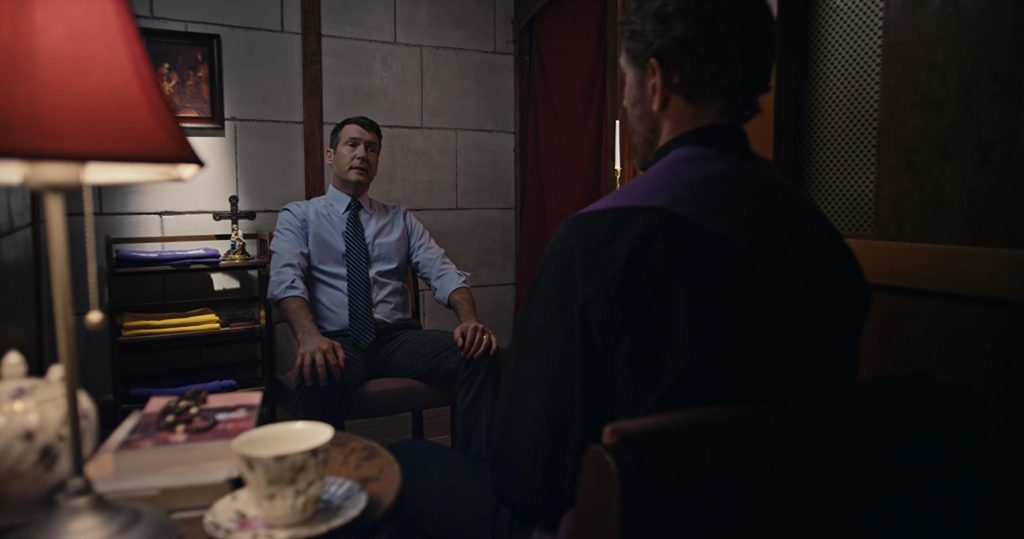
I love what you and Mark did with your lensing, the back and forth and back and forth. But you’re not whipsawing our heads like in a tennis match. And you expand, you widen your shots. When she’s being very suspect as to what she’s saying you’ve got a wider shot. But as the film progresses and then you strike on something that actually feels and sounds like the truth, you’ve got the camera going in closer on both of them. Then you’ll widen out just enough, and you’re holding shots, which I like so that we don’t get that whipsaw effect. Then with the other congregants who come in for confession, especially with Mary, that’s a really nice close mid-shot set up with both the pastor and Mary in the same frame together. You vary things up like that, from a story standpoint, so the visual supports the story and the characters emotional beats and I like how the two of you work that out.
Thank you. Because I knew this is a one-location movie, I wanted every scene to be slightly different. Whether it was just static shots for some of Amber and Father Morris, or with Rupert at the beginning. We kept the camera always moving and always slightly concealed because he’s a shady character. He’s always hiding behind things, he’s not always telling the truth. Or, like I said, with Mary and Father Morris, keeping them in the two-shot a lot of times, or over the shoulder to show that they’re connected, and there’s something there, there’s a relationship. Mark did a great job with the lighting and I’m really happy with what he did and always with his suggestions on set because I always have a thing where I do the whole shot list of the movie, but sometimes you’ve got to be organic, you’ve got to go with the flow.

Production design. I’ve got to talk to you about pulling in Aaron Kelly. The confessional design is beautiful. It’s stark, it’s sparse, it has clean lines, it gives the subconscious impression of everything being black and white, cut and dried, which is what so much of religion boils down to anyway. It’s like it’s good or bad, there’s no in-between, and you see that with the lines of the concrete walls and the precision with which the Bible is laying there, the candles on either side. Everything is very symmetrical, very, very aligned and it’s so visually appealing, Matthew.
A lot of it’s Aaron Kelly. It’s amazing what he did for such a little budget. I wish we could have given him so much more money, but he did this. He designed the whole thing. We talked about the colors and the style. He and Matt Thomason, our set constructor, put it all together themselves. I helped a little bit. Honestly, I’m useless at those kinds of things, but Aaron didn’t let me touch too much of it, just the stuff that I couldn’t break. I’m still just amazed at what he put together for so little money. That’s a completely just built set. For the final scene in the sanctuary we even had to transport one or two of the wall flats to another location just to give the illusion that they were actually next to each other, even though one we shot, the sanctuary in North Hollywood, in a Presbyterian church. The main location was in South LA. Like you said, clean lines. I grew up going to England when I was a kid and I’m living here now in London and I just wanted it to almost feel like an old parish church in England, those stone type quality. He did an amazing job.

That immediately struck me; the production design of that confessional. It says so much so that you don’t need to waste any words on exposition. You don’t have to waste dialogue. No wasted establishing shots. It says so much just looking at it. And then, the way Clayton sits there in the chair, almost afraid to move. It’s like he has to sit there, he’s on display almost. It all just works beautifully.
Thank you. And he has all his books there. The night that we have our confession, it seems like a busy night, but I’m guessing other nights you just sit there for an hour, nothing to do. That’s why we had the little library there. And Clay was actually the one that suggested the tea set because he was like, “You know, if I was here for three hours I need something.” And it was his idea to do that.
And the china tea set look with the teapot, the cup and saucer, it’s all perfectly placed, perfectly apportioned. And yes, you would expect to see that over a bottle of water. It has more grace and elegance, more propriety to it.
I think we made our set designer run out just an hour before we shot. It was like, “Okay, we need a tea set. Can you go and find us one? And you have to back in 30 minutes when we do our first shot.” It was just like, “Agh!”
It’s those little touches that matter so much in a film like this, Matthew, because it is essentially a two-hander, and with one set. You mentioned watching “Rope.” You think about “Rope” and even though there are a lot more people involved, it’s just one set. But you think about everything in that set, everything in that room that defines who Jimmy Stewart is, who his character is, and that’s what we have here. The devil is in the details in this one.
We thought about it just because in other movies every scene is all a new location. But this one, we have one location, so why don’t we think about everything? Why don’t we think about all the symbols, symbolism. And just why don’t we think about what we can because that’s the only thing we can control, what’s in front of the camera.
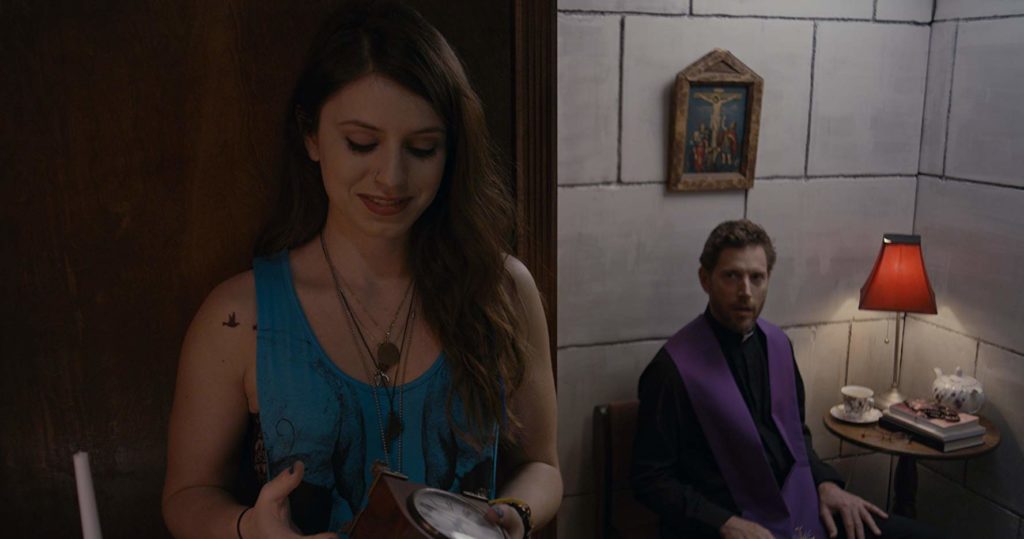
You did a beautiful job with that. So, I’m curious, Matthew, what was the learning curve like for you jumping into a feature film?
Honestly, I talk to a lot of filmmakers and they’re always worried, “Oh, I just don’t know if I can do a feature.” And honestly, it’s just not that different from a short film, at least in my mind. It’s interesting because I worked on a few bigger budget movies like “Sinister” and “Deliver Us From Evil”, and I would watch Scott, I would ask him questions, just try to soak it all up. But at the end of the day, it’s just not that different. The budgets are much, much bigger and if you need to need to get something, “Yeah, no problem. Let’s get that, you know, we have a couple million.” But with this one, you have to plan things out a lot more and roll with the punches if something doesn’t go right. But at the end of the day [on any film], you have your shot list, you set up the shot, you have your script and you go just shot by shot, scene by scene. I think that was the same for this. I probably directed a couple of hours of footage by the time I had done the feature, but it was still just taking day by day and said, “This is the day, this is what we have to do.” We split it up into scenes and then shots and the start marking off a list. And just like with, I think, most directors you can see the movie in your head beforehand. And you just hope it comes out slightly how you envision it.

I like your take on it because there are still so many directors who I speak with where it’s their first feature, they’ve done a lot of shorts, and they’re still going, “Oh my God, it was horrible, I didn’t think I’d make it through.” So, I like your very pragmatic and sensible take on this and that it’s not that much different. You put one foot in front of the other.
I think that’s at the end of the day, as a person watching Scott [Derrickson], one person can only do so much. So on those bigger budget things, you hire more people because one person can’t do everything. And you delegate. It’s all about delegation and the same with this. The reason I say it wasn’t that different, not to sound pompous, not to sound like, “Oh, it was easy”, because it wasn’t easy, no shoot I’ve ever done has been easy. It’s just that I think people need to give themselves more credit and if you directed a short, there’s not much stopping you from a feature. I think the harder things to keep in mind are pacing throughout the whole movie, just the flow of everything. But at the end of the day, if you can direct a three to five minute scene, then you can direct a feature. You just have to do that three-minute scene 40, 50 times. I know that sounds like, “Oh, just 40, 50 times,” but it really is. You’re just dividing it up. Maybe that’s why I like to do it because to me it does come natural. You could say it’s what I was meant to do.
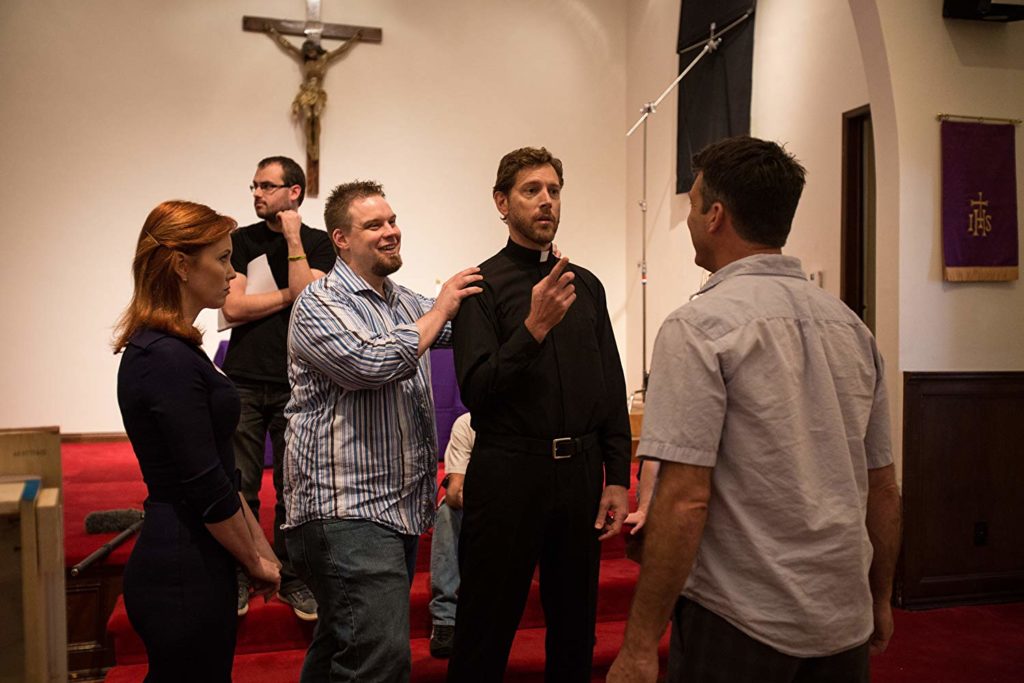
So, what is next on your plate? Will you be directing another feature?
Ah, well, hopefully. We’ll see how SURVIVING CONFESSION does. But yeah, I always have a ton of stuff planned. One of the producers for this, Jo Rauen, he and I are developing another feature together written by Mike Meade, it’s called “Nightfall”. This one would be more of a dramatic horror movie. In addition to that, I’m doing another movie with a producer here in London that’s more dramatic, fantastical, a dramatic movie more in the vein of SURVIVING CONFESSION. And I still would love to do that first movie that I met Shane with that still hasn’t gotten made. Maybe if enough people like SURVIVING CONFESSION we can finally make this amazing Japanese World War II prison horror movie.
by debbie elias, exclusive interview 07/31/2019












